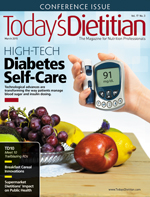 March 2015 Issue
March 2015 Issue
Nutrition Considerations for Patients With Rheumatoid Arthritis
The following are nutrition management goals to consider during assessment, diagnosis, intervention, monitoring, and evaluation of patients with rheumatoid arthritis (RA):
- achievement of nutritional adequacy and correction of nutrient deficiencies;
- management of medication side effects and medication-nutrient interactions;
- achievement and maintenance of a healthy BMI while preserving fat-free mass;
- prevention or treatment of comorbidities such as cardiovascular disease and osteoporosis;
- reduction of pain and inflammation; and
- optimization of food-related activities of daily living and quality of life.
Assessment |
Reasoning |
Body weight/BMI |
• Recent weight loss or gain |
Labs |
• Homocysteine, C-reactive protein, albumin, lipid panel, etc |
Activities of daily living |
• May affect shopping for, preparing, or eating food |
Diet history |
• History of treating RA with diet |
Medications |
• Nutrition-related side effects such as abdominal pain, stomatitis, weight gain, and ulcers |
Supplements |
• Safety and effectiveness |
Fluids |
• Meeting recommended targets |
Sex |
• Women often affected more severely in all respects |
Economic status |
• Food insecurity possible |
Mental health |
• Anxiety or depression often seen with RA |
Other |
|
Diagnosis/Comorbidities |
Considerations |
Level of disease activity |
• Can affect labs, resting energy expenditure, activities of daily living, weight, loss of fat-free mass, etc |
Cardiovascular disease |
• Will likely need intervention to minimize risk |
Osteoporosis |
• Will likely need intervention to minimize risk |
Rheumatoid cachexia/weight loss |
• Possible loss of fat-free mass |
Temporomandibular disorder |
• May have difficulty chewing |
Sjögren's Syndrome |
• May experience dry mouth |
Infections |
• Higher risk of infection |
Other |
|
Intervention |
Recommendations |
Calories |
• Resting energy expenditure may be elevated, but physical activity may be reduced |
Protein |
• No clear guidelines |
Fat |
• Monounsaturated fat encouraged, no specific amounts |
Vitamins and minerals |
• Use Dietary Reference Intakes as goal |
Fruits and vegetables |
• Address any issues with acquiring and consuming them |
Dietary patterns |
• Mediterranean, vegetarian, vegan, elemental, and elimination common |
Barriers |
• Diet may be hard to maintain |
Referrals and resources |
• Occupational therapist, fitness expert, or other as needed |
Other |
|
